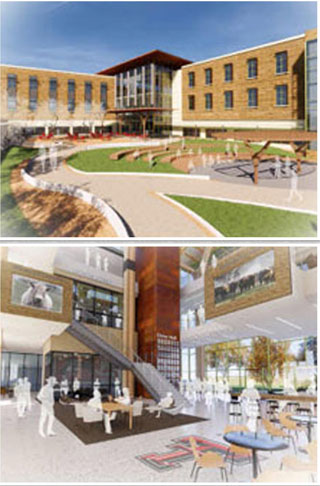
Texas Tech

Images courtesy of Texas Tech University
Construction is expected to begin next fall on a proposed veterinary school at Texas Tech University's Health Sciences Center in Amarillo. These conceptual renderings, which are subject to change, depict the school's main building. The university plans to construct a facility for some large animal clinical training but will not build a traditional teaching hospital. Instead, students will rotate through Texas Panhandle practices, feedlots and dairies for clinical training.
Nothing apparently has dampened Texas Tech's resolve to open a school of veterinary medicine — not the potential loss of a $10 million gift, the untimely exit of its beloved and influential chancellor or Texas A&M University's war on the budding program.
On Oct. 4, the Texas Tech University System Board of Regents approved the hiring of Western Builders, a local commercial contractor, to manage and oversee pre-construction of the veterinary school. The program is to occupy 250,000 square feet of space, including buildings, barns and open areas in and around Amarillo, the largest city in the Panhandle.
Total costs to develop the school are projected to run just shy of $90 million. The contract with Western Builders is worth around $80,000.
That deal is a small but important step for a proposal that's encountered resistance since 2015, when Tech announced development plans. While the university aims to funnel large animal practitioners into underserved rural areas of West Texas, critics say two public veterinary programs will drain the applicant pool and state resources.
Groundbreaking on Tech veterinary school is slated for fall 2019. The Council on Education, the nation's programmatic accreditor of veterinary education, will conduct a consultative site visit in April, and likely follow with a comprehensive site visit, which begins the formal review process. Assuming accreditation, Tech plans to admit 40 students to its inaugural class in fall 2021. Target enrollment is 60 students per year.
"So you can see, a lot is happening," said Dr. Guy Loneragan, a veterinary epidemiologist and professor at Tech who serves as acting administrator of the proposed veterinary school. "... Bottom line is that we are on track and on time."
Tech's Amarillo campus is an eight-hour drive northwest of College Station, home to the Texas A&M University College of Veterinary Medicine & Biomedical Sciences, founded in 1916. Approximately 60 percent of the 10,000-plus veterinarians licensed to practice in Texas are Aggies.
Some in Texas argue that A&M alone can fully serve the state's needs. That view was delivered forcefully by A&M Board of Regents Chairman Charles Schwartz during a speech last week before the Texas A&M Faculty Senate.
Schwartz called plans for Tech's program "lunatic" and implied that the institution can't compete with the dominance of A&M, local media reported.
He said that A&M already is addressing the perceived lack of veterinarians working in the rural Texas Panhandle. The A&M System is spending $90 million to expand its veterinary school to West Texas A&M. The campus in Canyon is minutes from where Tech plans to open its veterinary school in Amarillo. The new Veterinary Education, Research & Outreach Center will provide students at A&M's veterinary college in College Station with the opportunity to take courses, participate in externship programs and conduct research in the Panhandle by 2020.
Schwartz also signaled a potential battle over state funds. When the Texas Legislature convenes in January 2019, lawmakers will be making allocations to higher education, the veterinary schools included. During his speech, Schwartz said he considers the opening of a second veterinary program to be a waste of state resources.
A&M is a political powerhouse, as is noted by a columnist at the Texas Tribune. In August, Tech Chancellor Robert Duncan, one of the biggest advocates for opening a second veterinary school in Texas, suddenly retired. Some suspect the move was prompted by Gov. Greg Abbot on behalf of A&M. His office has denied it.
"There's no doubt that there (were) big power players, political power players, in the process," State Sen. Charles Perry told a local news station. "You can't take politics out of the politics."
Duncan, a revered and well-connected former Texas lawmaker, was expected to help secure approximately $17 million in state funds for Tech's program operations over the next two years. (An annual operating budget of $19.5 million is anticipated for the program.)
The loss of Duncan's lobbying power could have a negative impact on the program. It's already had an effect on a promised philanthropic gift.
After the chancellor's exit, Amarillo Mayor Jerry Hodge publicly rescinded the $10 million he promised to help fund the Tech veterinary school, stating that he agreed to support the program because Duncan is his friend. Without Duncan at the helm, there is no reason to give, he said.
Hodge since has stated that he may reconsider.
Loneragan, the Tech administrator, is hoping Hodge decides in the program's favor.
"We will continue to work with and engage Mayor Jerry Hodge and we certainly hope he will step forward again to donate," he said. "But even if he doesn't, he remains a vitally important stakeholder for our system, and we will work with and celebrate him. Above all else, he is a good and visionary person who has contributed to and enabled some of our most transformative programs over the years."
Tech aims to train veterinarians to work in the state's rural communities that are immersed in agriculture but lacking veterinarians. Amarillo is known as the beef capital of the world, home to roughly 2.5 million head of cattle. Throughout the area are more than a million hogs and nearly as many sheep. West Texas has emerged as one of the largest milk-producing regions in the nation.
There also are more Texas residents, many of whom own pets.
Workforce demand in Texas is on an upswing, spurring a need for more new graduates and veterinary education opportunities. Texas has outgrown the capacity of its sole veterinary school, Loneragan said.
"Seventy-five percent of the workforce needs now have to be met by out-of-state and out-of-country schools," he said. "More Texans study out-of-state than in-state."
Loneragan acknowledged that Tech can't force graduates to practice in rural areas; however, the school's plan is to select candidates who have an affinity for rural life. Companion animal practices, too, are hiring, he said.
"… We have heard from so many vets that this is needed for Texas and their businesses. Every time we hear from one, it steels our resolve to implement this vision and to implement it the right way," he said.